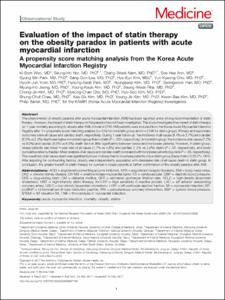KUMEL Repository
1. Journal Papers (연구논문)
1. School of Medicine (의과대학)
Dept. of Internal Medicine (내과학)
Evaluation of the impact of statin therapy on the obesity paradox in patients with acute myocardial infarction A propensity score matching analysis from the Korea Acute Myocardial Infarction Registry
- Keimyung Author(s)
- Hur, Seung Ho; Nam, Chang Wook; Kim, Hyung Seop; Cho, Yun Kyeong; Park, Hyoung Seob; Yoon, Hyuck Jun; Han, Seong Wook; Kim, Kwon Bae
- Department
- Dept. of Internal Medicine (내과학)
- Journal Title
- Medicine
- Issued Date
- 2017
- Volume
- 96
- Issue
- 35
- Keyword
- acute myocardial infarction; mortality; obesity; statins
- Abstract
- The phenomenon of obesity paradox after acute myocardial infarction (AMI) has been reported under strong recommendation of statin therapy. However, the impact of statin therapy on this paradox has not been investigated. This study investigated the impact of statin therapy on 1-year mortality according to obesity after AMI. A total of 2745 AMI patients were included from the Korea Acute Myocardial Infarction Registry after 1:4 propensity score matching analysis (n = 549 for nonstatin group and n = 2196 for statin group). Primary and secondary outcomes were all-cause and cardiac death, respectively. During 1-year follow-up, the incidence of all-cause (8.4% vs 3.7%) and cardiac (6.2% vs 2.3%) death was higher in nonstatin group than in statin (P < .001, respectively). In nonstatin group, the incidence of all-cause (7.2% vs 9.0%) and cardiac (5.5% vs 6.5%) death did not differ significantly between obese and nonobese patients. However, in statin group, obese patients had lower 1-year rate of all-cause (1.7% vs 4.8%) and cardiac (1.2% vs 2.9%) death (P < .05, respectively), and lower cumulative rates by Kaplan-Meier analysis of all-cause and cardiac death compared with nonobese patients (log-rank P < .05, respectively). The overall risk of all-cause death was significantly lower in obese than in nonobese patients only in statin group (hazard ratio: 0.35; P = .001). After adjusting for confounding factors, obesity was independently associated with decreased risk of all-cause death in statin group. In conclusion, the greater benefit of statin therapy for survival in obese patients is further confirmation of the obesity paradox after AMI.
- Publisher
- School of Medicine (의과대학)
- Citation
- Ki-Bum Won et al. (2017). Evaluation of the impact of statin therapy on the obesity paradox in patients with acute myocardial infarction A propensity score matching analysis from the Korea Acute Myocardial Infarction Registry. Medicine, 96(35), e7180–e7180. doi: 10.1097/MD.0000000000007180
- Type
- Article
- ISSN
- 0025-7974
- Appears in Collections:
- 1. School of Medicine (의과대학) > Dept. of Internal Medicine (내과학)
- 파일 목록
-
-
Download
 oak-2018-0492.pdf
기타 데이터 / 444.05 kB / Adobe PDF
oak-2018-0492.pdf
기타 데이터 / 444.05 kB / Adobe PDF
-
Items in Repository are protected by copyright, with all rights reserved, unless otherwise indicated.